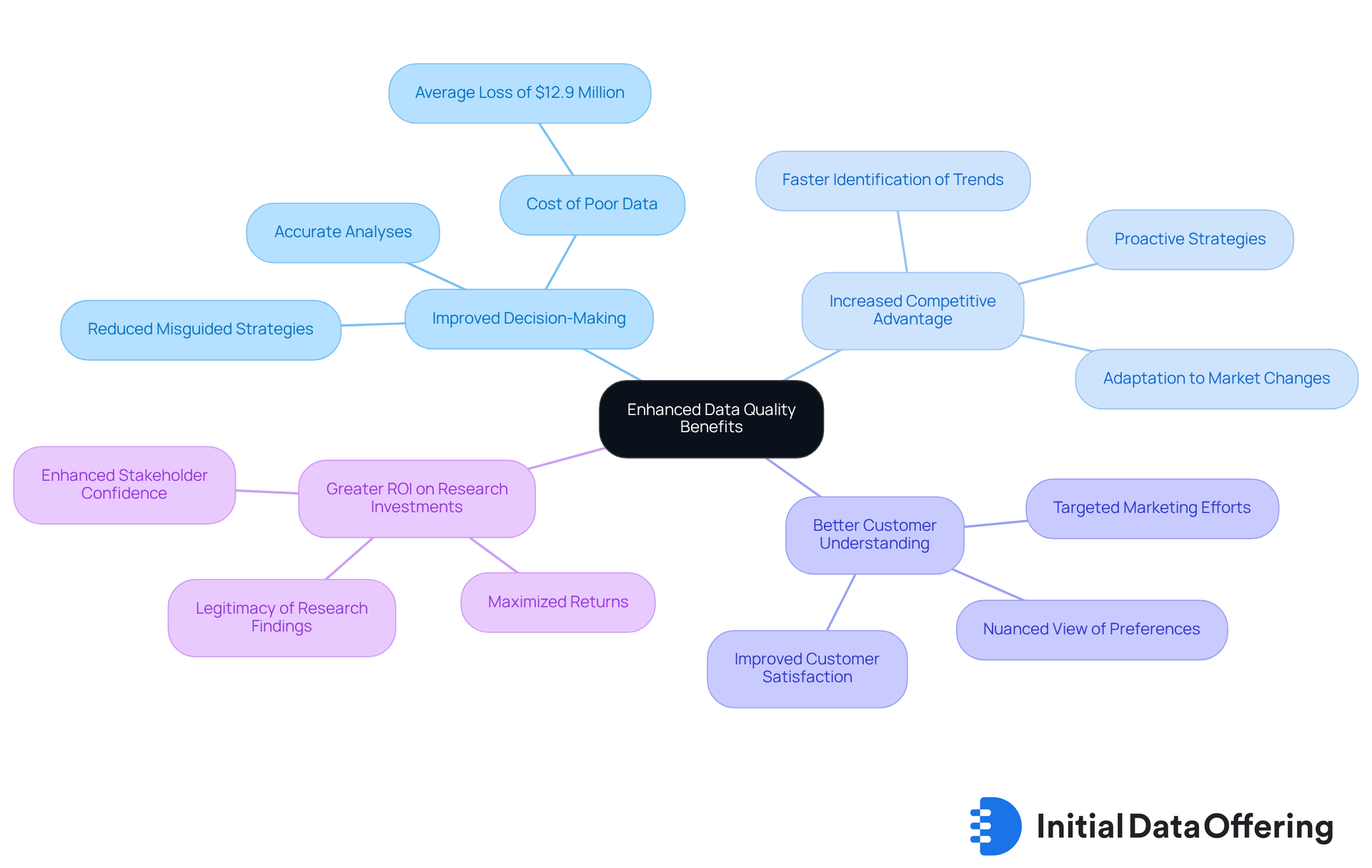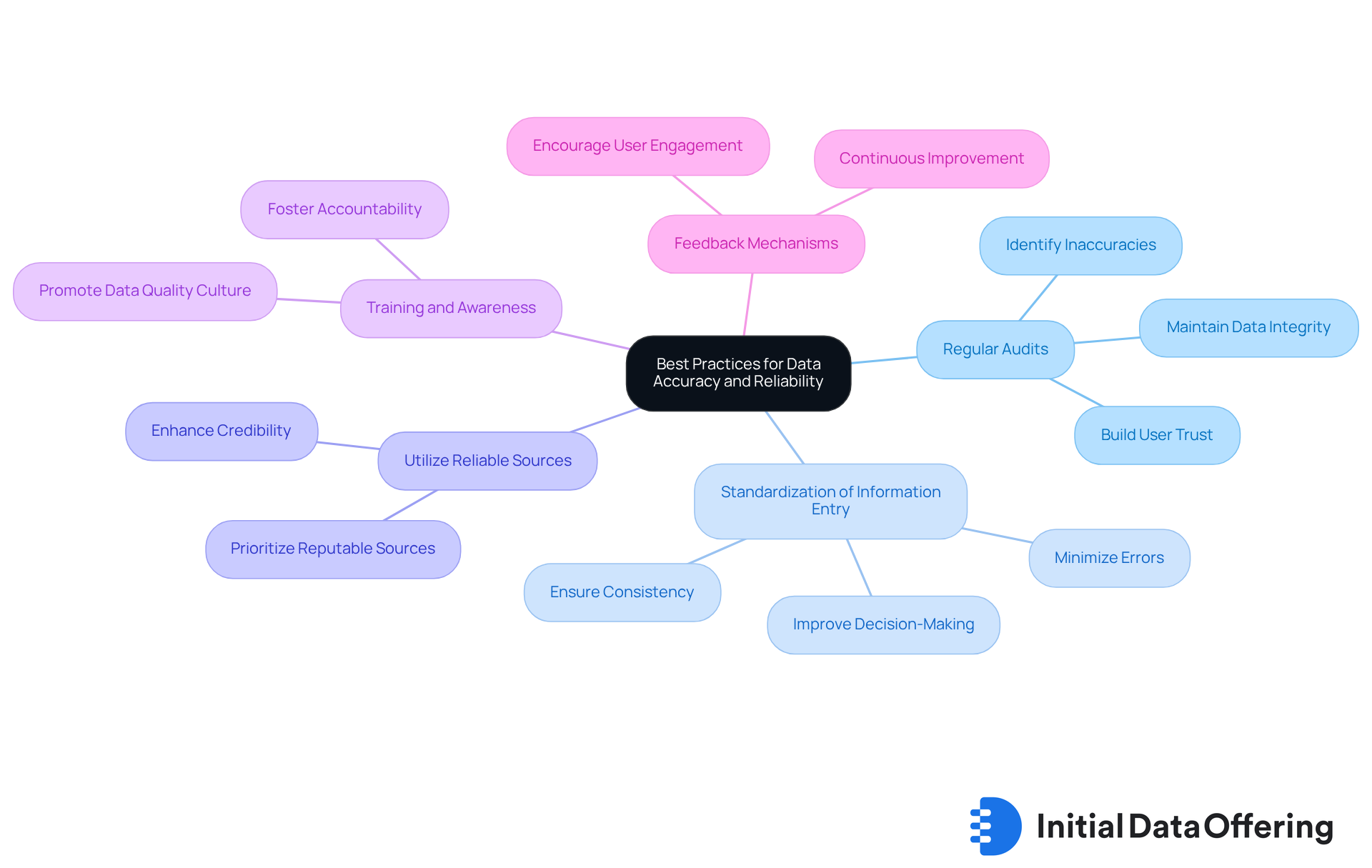Enhance Your Market Research: Best Practices for Data Enhancement

Enhance Your Market Research: Best Practices for Data Enhancement
Overview
This article delves into best practices for data enhancement in market research, highlighting its critical role in elevating data quality and informing decision-making. By systematically enhancing datasets, organizations can identify valuable information sources, integrate external data, and maintain quality through regular audits and user feedback.
Features:
- The systematic approach includes identifying information sources
- Integrating external data
- Conducting regular audits
Advantages:
- This method ensures that the data remains relevant and accurate, which is essential for deriving meaningful insights.
Benefits:
- Ultimately, these practices lead to more precise insights and provide a competitive edge for organizations.
How can these enhancements impact your organization? Consider the implications of improved data quality on your decision-making processes. By adopting these practices, you can not only enhance your datasets but also foster a culture of continuous improvement.
In conclusion, prioritizing data enhancement is not just about better data; it’s about making informed decisions that drive success. Organizations that invest in these practices will find themselves better equipped to navigate the complexities of the market.
Introduction
Data enhancement has become a crucial strategy in market research, turning raw data into actionable insights that can significantly influence business decisions. By integrating additional information and refining existing datasets, organizations gain a deeper understanding of consumer behavior and market trends. This not only drives strategic growth but also positions businesses to respond effectively to changing market dynamics.
However, as reliance on advanced analytics increases, so does the risk of data inaccuracies. How can businesses ensure that their enhanced datasets remain reliable and relevant in this ever-evolving landscape? This question is vital for organizations aiming to leverage data effectively.
By focusing on the features of enhanced datasets, such as improved accuracy and comprehensiveness, businesses can appreciate the advantages they offer, including better decision-making and increased competitive edge. Ultimately, the benefits of utilizing enhanced datasets are clear: they empower organizations to make informed choices that foster growth and innovation.
Define Data Enhancement and Its Importance in Market Research
Data enhancement is the process of improving the quality and value of information by integrating additional details or refining existing datasets. This approach is essential in industry research as it converts raw information into practical conclusions. Improved information offers a more thorough perspective on consumer behavior, industry trends, and competitive landscapes.
By utilizing data enhancement through external sources, such as demographic information or market reports, researchers can reveal deeper insights that drive strategic decisions. For instance, Media Radar utilizes advanced Natural Language Processing (NLP) to track real-time news and social media in 28 languages. This capability provides clients with prompt access to usable information through its API-accessible raw information feeds and user interface features, which include information filtering, alerts, and charting.
A substantial 81% of participants indicated utilizing or intending to utilize generative AI to produce synthetic information. This statistic highlights the increasing dependence on advanced analytics for enhanced decision-making abilities. Understanding data enhancement is crucial for any organization seeking to utilize insights effectively in their market research efforts. It not only improves the precision of findings but also reduces risks linked with introducing new products or entering new markets.
Moreover, the incorporation of valuable information greatly influences business results, facilitating informed decision-making and strategic planning. It is also essential to consider ethical information usage and privacy, ensuring that information enhancement practices uphold these standards, particularly in the context of Media Radar's capabilities. Consistently examining and verifying gathered information is vital to maintain its precision and significance over time, strengthening the continuous aspect of quality assurance.

Implement Steps for Effective Data Enhancement
To effectively enhance data in market research, consider the following steps:
-
Identify Information Sources: Start by pinpointing collections that can be enriched, including internal records, third-party information, or publicly available collections. This foundational step is crucial for ensuring a comprehensive enhancement process. By identifying these sources, you lay the groundwork for data enhancement that leads to a more robust dataset capable of driving better insights.
-
Assess Information Quality: Evaluate the current quality of your information by identifying gaps, inconsistencies, or outdated details. High-quality information is crucial; studies show that organizations excel over competitors in sales growth by utilizing precise customer understanding through data enhancement. How confident are you in the accuracy of your data? A thorough assessment can reveal areas for improvement.
-
Integrate Additional Information: Incorporate relevant external sources that can provide context or further insights. This may encompass demographic information, market trends, or consumer behavior studies, which can enrich the depth of your analysis. By integrating these elements, you achieve data enhancement that enhances the narrative your data tells, making it more actionable.
-
Utilize Information Cleaning Techniques: Implement information cleaning methods to eliminate duplicates, correct errors, and standardize formats. This step is essential for guaranteeing that the improved dataset undergoes data enhancement, ensuring it is dependable and prepared for analysis, as precise information is fundamental for effective marketing research. Have you considered how much cleaner data can improve your decision-making?
-
Analyze and Interpret Enhanced Data: After enhancement, conduct thorough analyses to extract meaningful insights. Utilize statistical tools and visualization methods to present findings clearly, facilitating informed decision-making based on data enhancement. The clearer your presentation, the more likely your insights will resonate with stakeholders.
-
Iterate and Update: Acknowledge that information enhancement is a continuous process. Frequently review and refresh datasets to uphold their significance and precision, guaranteeing that your findings stay practical and in accordance with present industry conditions. How often do you revisit your data? Regular updates ensure your insights remain relevant and impactful.

Explore Benefits of Enhanced Data Quality for Market Insights
Enhanced data quality offers numerous benefits for market research, including:
-
Improved Decision-Making: High-quality data leads to more accurate analyses, enabling businesses to make informed decisions based on reliable insights. Research indicates that inadequate information standards can cost companies an average of $12.9 million each year. This highlights the significance of investing in trustworthy information sources. Organizations that emphasize information quality can significantly reduce the risk of misguided strategies, which often arise from compromised information.
-
Increased Competitive Advantage: Organizations utilizing improved information can identify market opportunities and trends faster than their rivals, enabling proactive strategies. High-quality information allows businesses to spot emerging trends and shifts in consumer preferences, helping them adapt their offerings swiftly to changing dynamics and seize new opportunities.
Better customer understanding is facilitated by data enhancement, as enhanced datasets provide a more nuanced view of customer preferences and behaviors, aiding targeted marketing efforts and product development. This deeper understanding allows companies to tailor their offerings effectively, leading to improved customer satisfaction and loyalty.
- Greater ROI on Research Investments: By ensuring information quality, businesses can maximize the return on their research investments. Insights derived from trustworthy information are more actionable and impactful. High-quality information lends legitimacy to research findings, enhancing the credibility of business strategies and bolstering stakeholder confidence. For instance, firms that establish strong validation processes frequently observe a significant enhancement in their marketing ROI, as they can assign resources to the most effective channels.
How can your organization leverage enhanced data quality to drive better decision-making and customer satisfaction?

Adopt Best Practices for Ensuring Data Accuracy and Reliability
To ensure data accuracy and reliability, it's essential to adopt several best practices that can significantly contribute to data enhancement for the quality of your datasets.
-
Regular Audits: Conducting periodic audits of your datasets allows you to identify and rectify any inaccuracies or inconsistencies. This practice not only helps maintain data integrity but also supports data enhancement, building trust among users who rely on accurate information.
-
Standardization of Information Entry: Implementing standardized procedures for information entry minimizes errors and ensures consistency across datasets. By doing so, you create a more reliable data environment, which ultimately leads to better decision-making through data enhancement.
-
Utilize Reliable Sources: When sourcing external information, prioritize reputable and verified sources. This data enhancement improves the credibility of your datasets and ensures that the information you provide is trustworthy and accurate.
-
Training and Awareness: Informing team members about the significance of information integrity fosters a culture of accountability. When employees understand their role in preserving data quality, they are more likely to contribute positively to the organization’s data practices.
-
Feedback Mechanisms: Establishing feedback loops with data users allows for continuous improvement of data quality based on their experiences and insights. This not only enhances the datasets but also encourages user engagement and satisfaction.
How can these practices be integrated into your current processes? By adopting these strategies, you can significantly improve your data enhancement, which will lead to more accurate and reliable data, resulting in more informed decisions and better outcomes.

Conclusion
Data enhancement is a crucial aspect of market research, transforming raw data into actionable insights that inform strategic decision-making. By refining and integrating additional information, organizations gain a clearer understanding of consumer behavior, market trends, and competitive dynamics. This process not only improves the quality of insights but also reduces risks associated with launching new products or entering unfamiliar markets.
Several key practices for effective data enhancement have been highlighted:
- Identifying reliable information sources
- Assessing data quality
- Integrating external insights
These foundational steps lead to better decision-making and a stronger competitive edge. Regular audits, standardization of data entry, and fostering a culture of accountability within teams are essential for maintaining data accuracy and reliability. By emphasizing these practices, organizations can fully harness the potential of enhanced data quality.
The importance of data enhancement in market research is significant. Organizations that prioritize high-quality data benefit from improved customer understanding and greater ROI on research investments, positioning themselves to adapt swiftly to market changes. By embracing these best practices and committing to continuous improvement, businesses can uncover deeper insights, drive innovation, and achieve lasting success in an increasingly competitive landscape.
How can your organization leverage data enhancement to stay ahead? Consider the practices discussed and reflect on how they can be applied to your work for better outcomes.
Frequently Asked Questions
What is data enhancement?
Data enhancement is the process of improving the quality and value of information by integrating additional details or refining existing datasets.
Why is data enhancement important in market research?
Data enhancement is essential in market research as it converts raw information into practical conclusions, providing a thorough perspective on consumer behavior, industry trends, and competitive landscapes.
How can external sources contribute to data enhancement?
External sources, such as demographic information or market reports, can reveal deeper insights that drive strategic decisions when integrated into existing datasets.
What technology does Media Radar use for data enhancement?
Media Radar utilizes advanced Natural Language Processing (NLP) to track real-time news and social media in 28 languages, providing clients with prompt access to usable information.
What percentage of participants are using or planning to use generative AI for data enhancement?
A substantial 81% of participants indicated utilizing or intending to utilize generative AI to produce synthetic information.
How does data enhancement affect decision-making in organizations?
Understanding data enhancement improves the precision of findings, reduces risks associated with introducing new products or entering new markets, and facilitates informed decision-making and strategic planning.
What ethical considerations should be taken into account with data enhancement?
It is essential to consider ethical information usage and privacy, ensuring that data enhancement practices uphold these standards.
Why is it important to examine and verify gathered information consistently?
Consistently examining and verifying gathered information is vital to maintain its precision and significance over time, strengthening the continuous aspect of quality assurance.